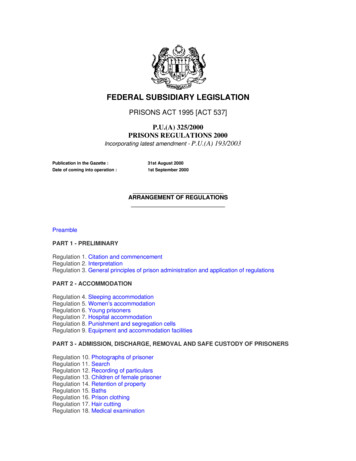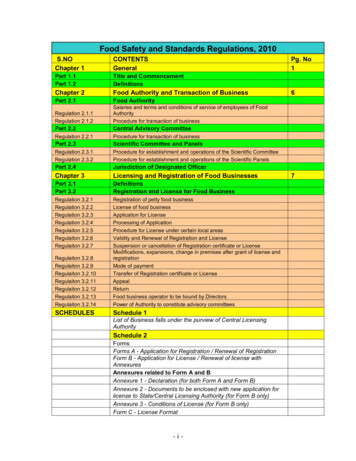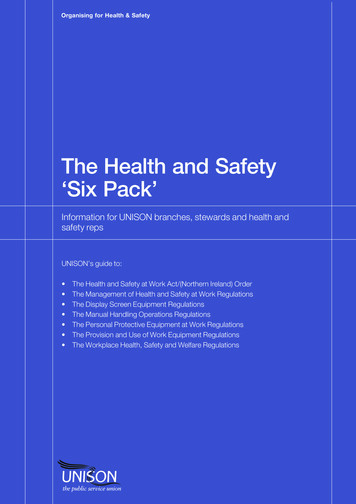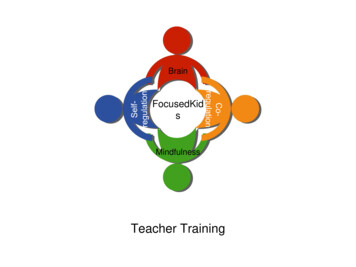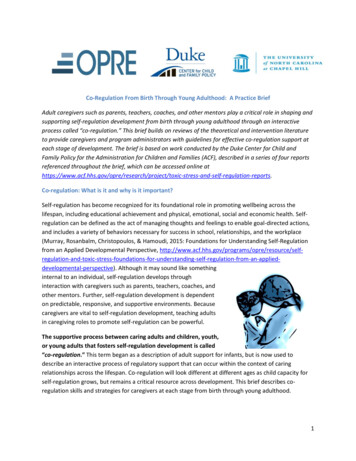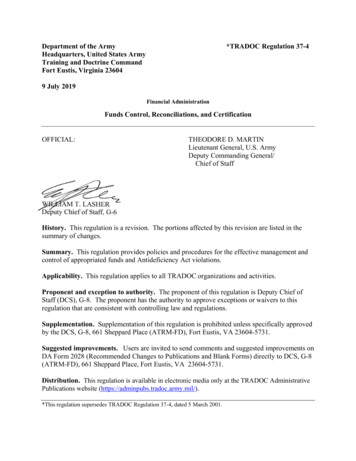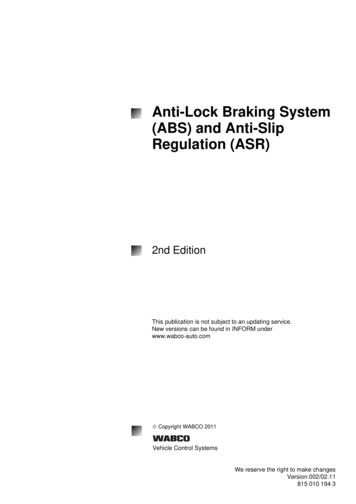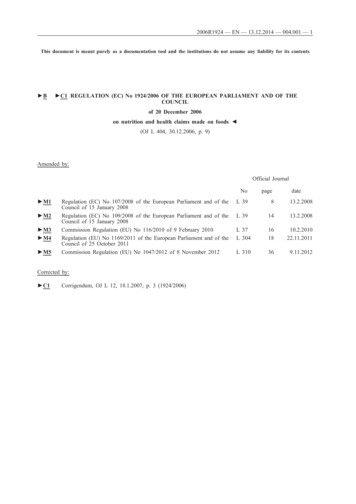
Transcription
2006R1924 — EN — 13.12.2014 — 004.001 — 1This document is meant purely as a documentation tool and the institutions do not assume any liability for its contents B C1 REGULATION (EC) No 1924/2006 OF THE EUROPEAN PARLIAMENT AND OF THECOUNCILof 20 December 2006on nutrition and health claims made on foods (OJ L 404, 30.12.2006, p. 9)Amended by:Official Journal M1 M2 M3 M4 M5Regulation (EC) No 107/2008 of the European Parliament and of theCouncil of 15 January 2008Regulation (EC) No 109/2008 of the European Parliament and of theCouncil of 15 January 2008Commission Regulation (EU) No 116/2010 of 9 February 2010Regulation (EU) No 1169/2011 of the European Parliament and of theCouncil of 25 October 2011Commission Regulation (EU) No 1047/2012 of 8 November 2012Corrected by: C1Corrigendum, OJ L 12, 18.1.2007, p. 3 (1924/2006)NopageL 39813.2.2008L 391413.2.2008L 37L 304161810.2.201022.11.2011L 310369.11.2012date
2006R1924 — EN — 13.12.2014 — 004.001 — 2 B C1REGULATION (EC) No 1924/2006 OF THE EUROPEANPARLIAMENT AND OF THE COUNCILof 20 December 2006on nutrition and health claims made on foodsTHE EUROPEAN PARLIAMENTEUROPEAN UNION,ANDTHECOUNCILOFTHEHaving regard to the Treaty establishing the European Community, andin particular Article 95 thereof,Having regard to the proposal from the Commission,Having regard to the Opinion of the European Economic and SocialCommittee (1),Acting in accordance with the procedure laid down in Article 251 of theTreaty (2),Whereas:(1)An increasing number of foods labelled and advertised in theCommunity bear nutrition and health claims. In order to ensurea high level of protection for consumers and to facilitate theirchoice, products put on the market, including imported products,should be safe and adequately labelled. A varied and balanceddiet is a prerequisite for good health and single products have arelative importance in the context of the total diet.(2)Differences between national provisions relating to such claimsmay impede the free movement of foods and create unequalconditions of competition. They thus have a direct impact onthe functioning of the internal market. It is therefore necessaryto adopt Community rules on the use of nutrition and healthclaims on foods.(3)General labelling provisions are contained in Directive2000/13/EC of the European Parliament and of the Council of20 March 2000 on the approximation of the laws of the MemberStates relating to the labelling, presentation and advertising offoodstuffs (3). Directive 2000/13/EC generally prohibits the useof information that would mislead the purchaser or attributemedicinal properties to food. This Regulation should complementthe general principles in Directive 2000/13/EC and lay downspecific provisions concerning the use of nutrition and healthclaims concerning foods to be delivered as such to the consumer.(1) OJ C 110, 30.4.2004, p. 18.(2) Opinion of the European Parliament of 26 May 2005 (OJ C 117 E,18.5.2006, p. 187), Council common position of 8 December 2005 (OJ C80 E, 4.4.2006, p. 43) and Position of the European Parliament of 16 May2006 (not yet published in the Official Journal). Council Decision of12 October 2006.3( ) OJ L 109, 6.5.2000, p. 29. Directive as last amended by Directive 2003/89/EC(OJ L 308, 25.11.2003, p. 15).
2006R1924 — EN — 13.12.2014 — 004.001 — 3 C1(4)This Regulation should apply to all nutrition and health claimsmade in commercial communications, including inter alia genericadvertising of food and promotional campaigns, such as thosesupported in whole or in part by public authorities. It shouldnot apply to claims which are made in non-commercial communi cations, such as dietary guidelines or advice issued by publichealth authorities and bodies, or non-commercial communicationsand information in the press and in scientific publications. ThisRegulation should also apply to trade marks and other brandnames which may be construed as nutrition or health claims.(5)Generic descriptors (denominations) which have traditionallybeen used to indicate a particularity of a class of foods orbeverages which could imply an effect on human health, suchas ‘digestive’ or ‘cough drops’, should be exempted from theapplication of this Regulation.(6)Non-beneficial nutrition claims are not covered by the scope ofthis Regulation; Member States intending to introduce nationalschemes relating to non-beneficial nutrition claims should notifysuch schemes to the Commission and to other Member States inaccordance with Directive 98/34/EC of the European Parliamentand of the Council of 22 June 1998 laying down a procedure forthe provision of information in the field of technical standardsand regulations and of rules on Information Society services (1).(7)At international level the Codex Alimentarius has adoptedGeneral Guidelines on Claims in 1991 and Guidelines for theUse of Nutrition Claims in 1997. An amendment to the latterhas been adopted by the Codex Alimentarius Commission in2004. That amendment concerns the inclusion of health claimsin the 1997 Guidelines. Due consideration is given to the defi nitions and conditions set in the Codex Guidelines.(8)The possibility of using the claim ‘low fat’ for spreadable fatsprovided for in Council Regulation (EC) No 2991/94 of5 December 1994 laying down standards for spreadable fats (2)should be adapted to the provisions of this Regulation as soon aspossible. In the meantime, Regulation (EC) No 2991/94 appliesfor the products it covers.(9)There is a wide range of nutrients and other substances including,but not limited to, vitamins, minerals including trace elements,amino-acids, essential fatty acids, fibre, various plants and herbalextracts with a nutritional or physiological effect that might bepresent in a food and be the subject of a claim. Therefore, generalprinciples applicable to all claims made on foods should be estab lished in order to ensure a high level of consumer protection, givethe consumer the necessary information to make choices in fullknowledge of the facts, as well as creating equal conditions ofcompetition for the food industry.(1) OJ L 204, 21.7.1998, p. 37. Directive as last amended by the 2003 Act ofAccession.(2) OJ L 316, 9.12.1994, p. 2.
2006R1924 — EN — 13.12.2014 — 004.001 — 4 C1(10)Foods promoted with claims may be perceived by consumers ashaving a nutritional, physiological or other health advantage oversimilar or other products to which such nutrients and othersubstances are not added. This may encourage consumers tomake choices which directly influence their total intake of indi vidual nutrients or other substances in a way which would runcounter to scientific advice. To address this potential undesirableeffect, it is appropriate to impose certain restrictions as regardsthe products bearing claims. In this context, factors such as thepresence of certain substances, or the nutrient profile of aproduct, are appropriate criteria for determining whether theproduct can bear claims. The use of such criteria at nationallevel, whilst justified for the purpose of allowing consumers tomake informed nutritional choices, is likely to result in barriers tointra-Community trade and should therefore be harmonised atCommunity level. Health information and communicationsupporting national authority or Community messages about thedangers of misuse of alcohol should not fall under the scope ofthis Regulation.(11)The application of nutrient profiles as a criterion would aim toavoid a situation where nutrition or health claims mask theoverall nutritional status of a food product, which couldmislead consumers when trying to make healthy choices in thecontext of a balanced diet. Nutrient profiles as provided for inthis Regulation should be intended for the sole purpose ofgoverning the circumstances in which claims may be made.They should be based on generally accepted scientific evidencerelative to the relationship between diet and health. However,profiles should also allow for product innovation and shouldtake into account the variability of dietary habits and traditions,and the fact that individual products may have an important rolein the context of an overall diet.(12)The establishment of nutrient profiles should take into accountthe content of different nutrients and substances with a nutritionalor physiological effect, in particular those such as fat, saturatedfat, trans-fatty acids, salt/sodium and sugars, excessive intakes ofwhich in the overall diet are not recommended, as well as polyand mono-unsaturated fats, available carbohydrates other thansugars, vitamins, minerals, protein and fibre. When setting thenutrient profiles, the different categories of foods and the placeand role of these foods in the overall diet should be taken intoaccount and due regard should be given to the various dietaryhabits and consumption patterns existing in the Member States.Exemptions from the requirement to respect established nutrientprofiles may be necessary for certain foods or categories of foodsdepending on their role and importance in the diet of the popu lation. These would be complex technical tasks and the adoptionof the relevant measures should be entrusted to the Commission,taking into account the advice of the European Food Safety Auth ority.
2006R1924 — EN — 13.12.2014 — 004.001 — 5 C1(13)Food supplements as defined in Directive 2002/46/EC of theEuropean Parliament and of the Council of 10 June 2002 onthe approximation of the laws of the Member States relating tofood supplements (1) presented in a liquid form and containingmore than 1,2 % by volume of alcohol are not considered asbeverages under this Regulation.(14)There is a wide variety of claims currently used in the labellingand advertising of foods in some Member States relating tosubstances that have not been shown to be beneficial or forwhich at present there is not sufficient scientific agreement. Itis necessary to ensure that the substances for which a claim ismade have been shown to have a beneficial nutritional or physio logical effect.(15)In order to ensure that the claims made are truthful, it isnecessary that the substance that is the subject of the claim ispresent in the final product in quantities that are sufficient, or thatthe substance is absent or present in suitably reduced quantities,to produce the nutritional or physiological effect claimed. Thesubstance should also be available to be used by the body. Inaddition, and where appropriate, a significant amount of thesubstance producing the claimed nutritional or physiologicaleffect should be provided by a quantity of the food that canreasonably be expected to be consumed.(16)It is important that claims on foods can be understood by theconsumer and it is appropriate to protect all consumers frommisleading claims. However, since the enactment of CouncilDirective 84/450/EEC of 10 September 1984 concerningmisleading and comparative advertising (2), the Court of Justiceof the European Communities has found it necessary in adjudi cating on advertising cases to examine the effect on a notional,typical consumer. In line with the principle of proportionality,and to enable the effective application of the protectivemeasures contained in it, this Regulation takes as a benchmarkthe average consumer, who is reasonably well-informed andreasonably observant and circumspect, taking into accountsocial, cultural and linguistic factors, as interpreted by theCourt of Justice, but makes provision to prevent the exploitationof consumers whose characteristics make them particularlyvulnerable to misleading claims. Where a claim is specificallyaimed at a particular group of consumers, such as children, itis desirable that the impact of the claim be assessed from theperspective of the average member of that group. The averageconsumer test is not a statistical test. National courts and auth orities will have to exercise their own faculty of judgment, havingregard to the case-law of the Court of Justice, to determine thetypical reaction of the average consumer in a given case.(1) OJ L 183, 12.7.2002, p. 51. Directive as amended by Commission Directive2006/37/EC (OJ L 94, 1.4.2006, p. 32).(2) OJ L 250, 19.9.1984, p. 17. Directive as last amended by Directive2005/29/EC of the European Parliament and of the Council (OJ L 149,11.6.2005, p. 22).
2006R1924 — EN — 13.12.2014 — 004.001 — 6 C1(17)Scientific substantiation should be the main aspect to be takeninto account for the use of nutrition and health claims and thefood business operators using claims should justify them. A claimshould be scientifically substantiated by taking into account thetotality of the available scientific data, and by weighing theevidence.(18)A nutrition or health claim should not be made if it is incon sistent with generally accepted nutrition and health principles orif it encourages or condones excessive consumption of any foodor disparages good dietary practice.(19)Given the positive image conferred on foods bearing nutritionand health claims and the potential impact these foods mayhave on dietary habits and overall nutrient intakes, theconsumer should be able to evaluate their global nutritionalquality. Therefore, nutrition labelling should be compulsory andshould be extensive on all foods bearing health claims.(20)General nutritional labelling provisions are contained in CouncilDirective 90/496/EEC of 24 September 1990 on nutritionlabelling for foodstuffs (1). According to that Directive, where anutrition claim appears on labelling, in presentation or in adver tising, with the exclusion of generic advertising, nutritionlabelling should be compulsory. Where a nutrition claim ismade for sugars, saturates, fibre or sodium, the information tobe given should be that of Group 2 as defined in Article 4(1) ofDirective 90/496/EEC. In order to achieve a high level ofconsumer protection, this obligation to provide the informationof Group 2 should apply mutatis mutandis where any healthclaim is made, with the exception of generic advertising.(21)A list of permitted nutrition claims and their specific conditionsof use should also be created based on the conditions for the useof such claims that have been agreed at national or internationallevel and laid down in Community legislation. Any claimconsidered to have the same meaning for consumers as anutrition claim included in the abovementioned list should besubject to the same conditions of use indicated therein. Forexample, claims related to the addition of vitamins andminerals such as ‘with ’, ‘restored ’, ‘added ’, or‘enriched ’ should be subject to the conditions set for theclaim ‘source of ’. The list should be regularly updated inorder to take into account scientific and technological devel opments. Furthermore, for comparative claims it is necessarythat the products being compared be clearly identified to thefinal consumer.(1) OJ L 276, 6.10.1990, p. 40. Directive as last amended by CommissionDirective 2003/120/EC (OJ L 333, 20.12.2003, p. 51).
2006R1924 — EN — 13.12.2014 — 004.001 — 7 C1(22)Conditions for claims such as ‘lactose-free’ or ‘gluten-free’,addressed to a group of consumers with specific disorders,should be dealt with in Council Directive 89/398/EEC of3 May 1989 on the approximation of the laws of the MemberStates relating to foodstuffs intended for particular nutritionaluses (1). In addition, that Directive provides the possibility thatfoodstuffs for normal consumption can indicate their suitabilityfor use by these groups of consumers if they fulfil the conditionsfor such statement. Until the conditions for such statements areset at Community level, Member States may maintain or adoptrelevant national measures.(23)Health claims should only be authorised for use in theCommunity after a scientific assessment of the highest possiblestandard. In order to ensure harmonised scientific assessment ofthese claims, the European Food Safety Authority should carryout such assessments. Upon request the applicant should be ableto have access to his file to check the state of the procedure.(24)There are many factors, other than dietary ones, that caninfluence psychological and behavioural functions. Communi cation on these functions is thus very complex and it isdifficult to convey a comprehensive, truthful and meaningfulmessage in a short claim to be used in the labelling and adver tising of foods. Therefore, it is appropriate, when using psycho logical and behavioural claims, to require scientific substantiation.(25)In the light of Commission Directive 96/8/EC of 26 February1996 on foods intended for use in energy-restricted diets forweight reduction (2) which prohibits, in the labelling, presentationand advertising of products covered by that Directive, anyreference to the rate or amount of weight loss which mayresult from their use, it is considered appropriate to extend thisrestriction to all foods.(26)Health claims other than those referring to the reduction ofdisease risk and to children's development and health, based ongenerally accepted scientific evidence, should undergo a differenttype of assessment and authorisation. It is therefore necessary toadopt a Community list of such permitted claims after consultingthe European Food Safety Authority. Furthermore, in order tostimulate innovation, those health claims which are based onnewly developed scientific evidence should undergo an accel erated type of authorisation.(27)In order to keep up with scientific and technological devel opments, the list referred to above should be revised promptlywhenever necessary. Such revisions are implementing measuresof a technical nature and their adoption should be entrusted to theCommission in order to simplify and expedite the procedure.(1) OJ L 186, 30.6.1989, p. 27. Directive as last amended by Regulation (EC)No 1882/2003 of the European Parliament and of the Council (OJ L 284,31.10.2003, p. 1).(2) OJ L 55, 6.3.1996, p. 22.
2006R1924 — EN — 13.12.2014 — 004.001 — 8 C1(28)Diet is one of the many factors influencing the onset of certainhuman diseases. Other factors such as age, genetic predisposition,the level of physical activity, the consumption of tobacco andother drugs, environmental exposure and stress may allinfluence the onset of human diseases. Specific labellingrequirements should therefore apply in respect of claimsrelating to the reduction of a disease risk.(29)In order to ensure that health claims are truthful, clear, reliableand useful to the consumer in choosing a healthy diet, thewording and the presentation of health claims should be takeninto account in the opinion of the European Food SafetyAuthority and in subsequent procedures.(30)In some cases, scientific risk assessment alone cannot provide allthe information on which a risk management decision should bebased. Other legitimate factors relevant to the matter underconsideration should therefore be taken into account.(31)For the sake of transparency and in order to avoid multipleapplications in respect of claims which have already beenassessed, a public Register containing the lists of such claimsshould be established and updated by the Commission.(32)In order to stimulate research and development within the agrifood industry, it is appropriate to protect the investment made byinnovators in gathering the information and data supporting anapplication under this Regulation. This protection should howeverbe limited in time in order to avoid the unnecessary repetition ofstudies and trials, and to facilitate access to claims by small andmedium-sized enterprises (SMEs), which rarely have the financialcapacity to carry out research activities.(33)SMEs represent an important added value to the European foodindustry in terms of quality and preservation of different dietaryhabits. In order to facilitate the implementation of this Regu lation, the European Food Safety Authority should makeavailable appropriate technical guidance and tools, in due time,especially for SMEs.(34)Given the particular nature of foods bearing claims, additionalmeans to those usually available to monitoring bodies shouldbe available in order to facilitate efficient monitoring of thoseproducts.(35)Adequate transitional measures are necessary to enable foodbusiness operators to adapt to the requirements of this Regulation.(36)Since the objective of this Regulation, namely to ensure theeffective functioning of the internal market as regards nutritionand health claims whilst providing a high level of consumerprotection, cannot be sufficiently achieved by the MemberStates and can therefore be better achieved at Community level,
2006R1924 — EN — 13.12.2014 — 004.001 — 9 C1the Community may adopt measures, in accordance with theprinciple of subsidiarity as set out in Article 5 of the Treaty. Inaccordance with the principle of proportionality as set out in thatArticle, this Regulation does not go beyond what is necessary inorder to achieve that objective.(37)The measures necessary for the implementation of this cision 1999/468/EC of 28 June 1999 laying down theprocedures for the exercise of implementing powers conferredon the Commission (1),HAVE ADOPTED THIS REGULATION:CHAPTER ISUBJECT MATTER, SCOPE AND DEFINITIONSArticle 1Subject matter and scope1.This Regulation harmonises the provisions laid down by law,regulation or administrative action in Member States which relate tonutrition and health claims in order to ensure the effective functioningof the internal market whilst providing a high level of consumerprotection.2.This Regulation shall apply to nutrition and health claims made incommercial communications, whether in the labelling, presentation oradvertising of foods to be delivered as such to the final consumer. M1In the case of non-prepackaged foodstuffs (including fresh productssuch as fruit, vegetables or bread) put up for sale to the finalconsumer or to mass caterers and foodstuffs packed at the point ofsale at the request of the purchaser or pre-packaged with a view toimmediate sale, Article 7 and Article 10(2)(a) and (b) shall not apply.National provisions may apply until the eventual adoption ofCommunity measures designed to amend non-essential elements ofthis Regulation, inter alia, by supplementing it, in accordance with theregulatory procedure with scrutiny referred to in Article 25(3). C1This Regulation shall also apply in respect of foods intended for supplyto restaurants, hospitals, schools, canteens and similar mass caterers.3.A trade mark, brand name or fancy name appearing in thelabelling, presentation or advertising of a food which may beconstrued as a nutrition or health claim may be used without undergoingthe authorisation procedures provided for in this Regulation, providedthat it is accompanied by a related nutrition or health claim in thatlabelling, presentation or advertising which complies with the provisionsof this Regulation.(1) OJ L 184, 17.7.1999, p. 23.
2006R1924 — EN — 13.12.2014 — 004.001 — 10 M14.For generic descriptors (denominations) which have traditionallybeen used to indicate a particularity of a class of foods or beverageswhich could imply an effect on human health, a derogation fromparagraph 3 designed to amend non-essential elements of this Regu lation by supplementing it may be adopted in accordance with theregulatory procedure with scrutiny referred to in Article 25(3), on appli cation by the food business operators concerned. The application shallbe sent to the national competent authority of a Member State whichwill forward it to the Commission without delay. The Commission shalladopt and make public the rules for food business operators accordingto which such applications shall be made, so as to ensure that theapplication is dealt with transparently and within a reasonable time. C15.This Regulation shall apply without prejudice to the followingCommunity provisions:(a) Directive 89/398/EEC and Directives adopted relating to foodstuffsfor particular nutritional uses;(b) Council Directive 80/777/EEC of 15 July 1980 on the approxi mation of the laws of the Member States relating to the exploitationand marketing of natural mineral waters (1);(c) Council Directive 98/83/EC of 3 November 1998 on the quality ofwater intended for human consumption (2);(d) Directive 2002/46/EC.Article 2Definitions1.For the purposes of this Regulation:(a) the definitions of ‘food’, ‘food business operator’, ‘placing on themarket’, and ‘final consumer’ set out in Articles 2, 3(3), 3(8) and3(18) of Regulation (EC) No 178/2002 of the European Parliamentand of the Council of 28 January 2002 laying down the generalprinciples and requirements of food law, establishing the EuropeanFood Safety Authority and laying down procedures in matters offood safety (3) shall apply;(b) the definition of ‘food supplement’ set out in Directive 2002/46/ECshall apply;(c) the definitions of ‘nutrition labelling’, ‘protein’, ‘carbohydrate’,‘sugars’, ‘fat’, ‘saturates’, ‘mono-unsaturates’, ‘poly-unsaturates’,‘fibre’ set out in Directive 90/496/EEC shall apply;(d) the definition of ‘labelling’ set out in Article 1(3)(a) of Directive2000/13/EC shall apply.(1) OJ L 229, 30.8.1980, p. 1. Directive as last amended by Regulation (EC) No1882/2003.(2) OJ L 330, 5.12.1998, p. 32. Directive as amended by Regulation (EC) No1882/2003.(3) OJ L 31, 1.2.2002, p. 1. Regulation as last amended by Commission Regu lation (EC) No 575/2006 (OJ L 100, 8.4.2006, p. 3).
2006R1924 — EN — 13.12.2014 — 004.001 — 11 C12.The following definitions shall also apply:1) ‘claim’ means any messagemandatory under Communitypictorial, graphic or symbolicstates, suggests or implies thator representation, which is notor national legislation, includingrepresentation, in any form, whicha food has particular characteristics;2) ‘nutrient’ means protein, carbohydrate, fat, fibre, sodium, vitaminsand minerals listed in the Annex to Directive 90/496/EEC, andsubstances which belong to or are components of one of thosecategories;3) ‘other substance’ means a substance other than a nutrient that has anutritional or physiological effect;4) ‘nutrition claim’ means any claim which states, suggests or impliesthat a food has particular beneficial nutritional properties due to:(a) the energy (calorific value) it(i) provides;(ii) provides at a reduced or increased rate; or(iii) does not provide; and/or(b) the nutrients or other substances it(i) contains;(ii) contains in reduced or increased proportions; or(iii) does not contain;5) ‘health claim’ means any claim that states, suggests or implies that arelationship exists between a food category, a food or one of itsconstituents and health;6) ‘reduction of disease risk claim’ means any health claim that states,suggests or implies that the consumption of a food category, a foodor one of its constituents significantly reduces a risk factor in thedevelopment of a human disease;7) ‘Authority’ means the European Food Safety Authority establishedby Regulation (EC) No 178/2002.CHAPTER IIGENERAL PRINCIPLESArticle 3General principles for all claimsNutrition and health claims may be used in the labelling, presentationand advertising of foods placed on the market in the Community only ifthey comply with the provisions of this Regulation.Without prejudice to Directives 2000/13/EC and 84/450/EEC, the use ofnutrition and health claims shall not:(a) be false, ambiguous or misleading;(b) give rise to doubt about the safety and/or the nutritional adequacy ofother foods;
2006R1924 — EN — 13.12.2014 — 004.001 — 12 C1(c) encourage or condone excess consumption of a food; M1(d) state, suggest or imply that a balanced and varied diet cannotprovide appropriate quantities of nutrients in general. Derogationsin the case of nutrients for which sufficient quantities cannot beprovided by a balanced and varied diet, including the conditionsfor their application, and designed to amend non-essential elementsof this Regulation by supplementing it may be adopted inaccordance with the regulatory procedure with scrutiny referred toin Article 25(3), taking into account the special conditions presentin Member States; C1(e) refer to changes in bodily functions which could give rise to orexploit fear in the consumer, either textually or through pictorial,graphic or symbolic representations.Article 4Conditions for the use of nutrition and health claims M11.By 19 January 2009, the Commission shall establish specificnutrient profiles, including exemptions, which food or certain categoriesof food must comply with in order to bear nutrition or health claims andthe conditions for the use of nutrition or health claims for foods orcategories of foods with respect to the nutrient profiles. Suchmeasures, designed to amend non-essential elements of this Regulationby supplementing it, shall be adopted in accordance with the regulatoryprocedure with scrutiny referred to in Article 25(3). C1The nutrient profiles for food and/or certain categories of food shall beestablished taking into account in particular:(a) the quantities of certain nutrients and other substances contained inthe food, such as fat, saturated fatty acids, trans-fatty acids, sugarsand salt/sodium;(b) the role and importance of the food (or of categories of food) andthe contribution to the diet of the population in general or, asappropriate, of certain risk groups including children;(c) the overall nutritional composition of the food and the presence ofnutrients that have been scientifically recognised as having an effecton health.The nutrient profiles shall be based on scientific knowledge about dietand nutrition, and their relation to health.In setting the nutrient profiles, the Commission shall request theAuthority to provide within 12 months relevant scientific advice,focusing in particular on:(i) whether profiles should be set for food in general and/or categoriesof food;
2006R1924 — EN — 13.12.2014 — 004.001 — 13 C1(ii) the choice and bala
(13) Food supplements as defined in Directive 2002/46/EC of the European Parliament and of the Council of 10 June 2002 on the approximation of the laws of the Member States relating to food supplements (1) presented in a liquid form and containing more than 1,2 % by volume of alcohol are not considered as
